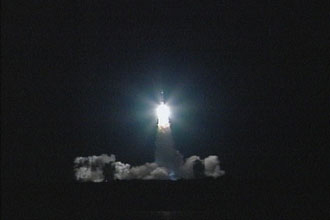NASA's STEREO Spacecraft Begin Sun-watching Mission

A pair of Sun-watching satellites launched into thenight sky above Florida late Wednesday, kicking off a NASA mission to take three-dimensional(3-D) images of our nearest star.
NASA's nearlyidentical STEREOspacecraft rocketed spaceward atop a Boeing Delta 2 booster after asuccessful 8:52 p.m. EDT (0038 Oct. 26 GMT) liftoff from Cape Canaveral AirForce Station.
"Thesatellites are in their intended orbit and everything went as planned," NASA launch director Omar Baez said justafter liftoff.
With their uniqueflying formation--one STEREO vehicle will eventually lead the Earth whilethe other lags behind--the satellites will generate the first near real-time, 3-Dimages of the Sun. STEREO's solar quarries are coronalmass ejections (CMEs), immense eruptions from the Sun that spew high-energy particles which canpose a radiationhazard for astronauts and satellites,as well as interfere with power and communications systems on Earth.
With NASA'splan to send astronauts on long-duration missions to the Moon--let alone a future multiple-yeartrip of a Mars-bound flight--more dependable CME and space weather predictionwill prove vital, researchers said.
"They can receivea year's worth of radiation in one of these storms," STEREO project managerNicholas Chrissotimos, of NASA's Goddard Space FlightCenter, said of astronauts working outside a spacecraft or lunar shelter. "Ifwe can predict when these storms occur, we can at least safe the astronautsduring these timeframes so they are not exposed to this environment."
Engineersat the Johns Hopkins University's Applied Physics Laboratory built the STEREOspacecraft for NASA, and will oversee the $550 million mission from a controlcenter in Laurel, Maryland.
Get the Space.com Newsletter
Breaking space news, the latest updates on rocket launches, skywatching events and more!
Thursday'slaunch came after a series of delays, including last-minute range safety andbooster concerns that were ultimately cleared, but only after pushing the spaceshot to the end of its 15-minute launch window.
"We are atthe dawn of a new age of solar observation," said theU.S. Naval Research Laboratory's Russ Howard, principal investigator for one ofSTEREO's instrument suites. "We are going to be viewing things in a newdimension."
Eyes onthe Sun
The twin STEREO--shortfor Solar Terrestrial Relations Observatory--spacecraft are aptly named. Onvehicle, billed as Ahead, is destined to lead the Earth in its orbit while the satellite'sBehind counterpart will lag aft of the planet.
In order toreach their final positions, STEREO's Ahead vehicle will slingshot around theMoon to move into an Earth-leading orbit. The Behind vehicle, meanwhile, willmake another swing past the Moon to reach its Earth-trailing position. Both STEREOspacecraft are expected to slowly widen the gap between each other over time,mission managers said.
Each STEREOsatellite packs 16 Sun-watching instruments into a frame about the size of agolf cart and weighs about 1,364 pounds (620 kilograms). Researchers hope tobring the Sun-watching duo online after a 90-day checkout period to add to currentassets like Solar and HeliosphericObservatory (SOHO) and other missions such as Windand AdvancedComposition Explorer (ACE).
"Just likeyou cannot measure ocean current with just a few buoys, you really cannot tryto understand this space environment with just a few observatories," NASA'sSTEREO program scientist Madhulika Guhathakurta saidbefore today's launch.
- Double Vision: STEREO Spacecraft to Scan Sun in 3D
- IMAGES: Sun Storms
- IMAGES: Solar Flares
- LIVE Sun Cam
Join our Space Forums to keep talking space on the latest missions, night sky and more! And if you have a news tip, correction or comment, let us know at: community@space.com.

Tariq is the Editor-in-Chief of Space.com and joined the team in 2001, first as an intern and staff writer, and later as an editor. He covers human spaceflight, exploration and space science, as well as skywatching and entertainment. He became Space.com's Managing Editor in 2009 and Editor-in-Chief in 2019. Before joining Space.com, Tariq was a staff reporter for The Los Angeles Times covering education and city beats in La Habra, Fullerton and Huntington Beach. In October 2022, Tariq received the Harry Kolcum Award for excellence in space reporting from the National Space Club Florida Committee. He is also an Eagle Scout (yes, he has the Space Exploration merit badge) and went to Space Camp four times as a kid and a fifth time as an adult. He has journalism degrees from the University of Southern California and New York University. You can find Tariq at Space.com and as the co-host to the This Week In Space podcast with space historian Rod Pyle on the TWiT network. To see his latest project, you can follow Tariq on Twitter @tariqjmalik.









